The Microsoft Surface Laptop 3 Showdown: AMD's Ryzen Picasso vs. Intel's Ice Lake
by Brett Howse & Andrei Frumusanu on December 13, 2019 8:30 AM ESTSystem Performance
Moving on from SPEC to some of our more traditional laptop tests, I’ve taken the opportunity to add some new tests to the suite, which we’ll include on all laptops going forward. While SPEC is a fantastic set of tests to probe the limits of a platform, not everyone is going to run a workload that runs at nearly 100% CPU utilization for such a long time on a laptop. The 8-Thread tests took 4.5 hours to complete on Ice Lake, and 6.5 hours to complete on Picasso, which is likely not something most people would turn to a thin and light laptop for, so it’s important to see how both platforms perform on shorter tests where they can leverage their peak boost frequencies for a higher percentage of the duration.
PCMark 10
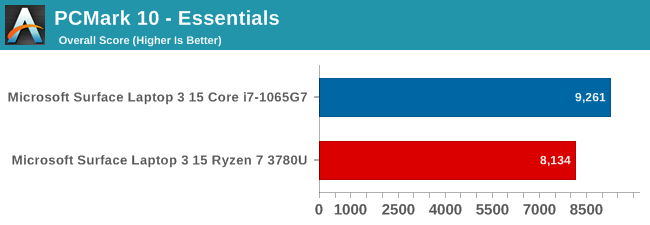

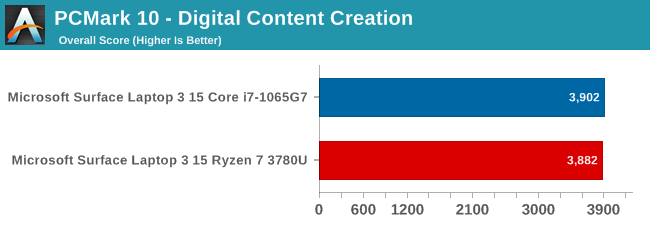
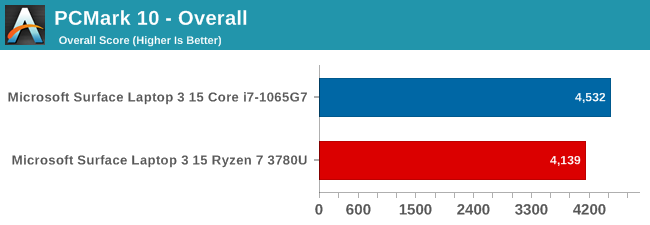
PCMark 10 consists of several real-world tests, including web, video conferencing, spreadsheets, writing, and more. There are several GPU tests as well, including rendering, and some gaming. The suite also measures application start-up, and all aspects of the system’s performance factor into the score.
Intel’s CPU performance lead shows clearly here again, with significant leads in both the Essentials and Productivity tests, although AMD’s strong GPU pulls the Ryzen system very close on the Digital Content Creation tasks. But that is not enough to turn the tide, and the Ice Lake platform carries this win.
Cinebench R20
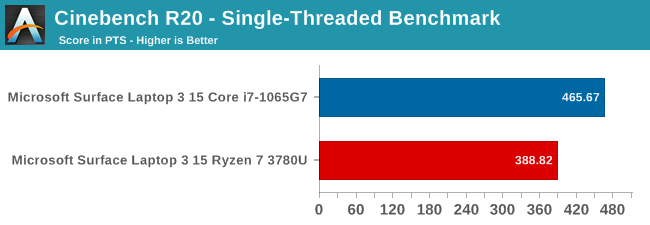
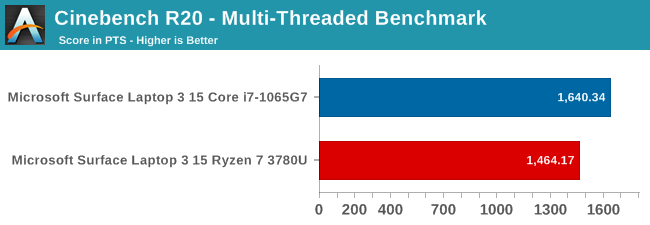
Looking at the latest version of Cinebench tells a similar story as to what we’ve seen so far. Ice Lake’s significant IPC lead pulls it way ahead. On the multi-threaded test, the AMD platform does close the gap somewhat, which is similar to the SPEC rate 8 results.
7-Zip
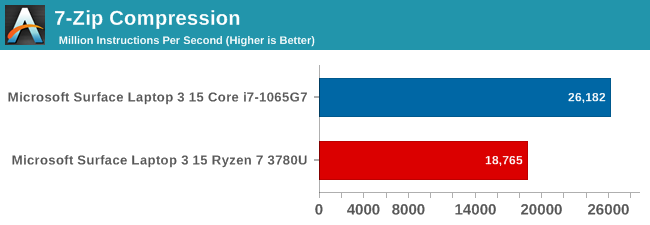
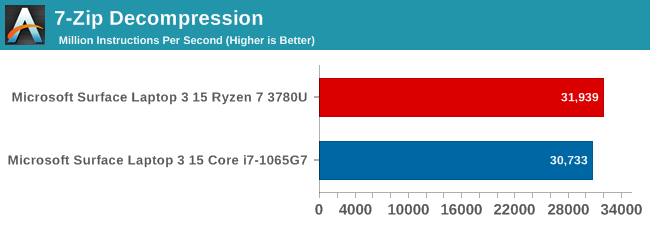
Checking out the popular 7-Zip file compression tool, the results are in-line with what we see in the desktop space. Intel generally has a lead on the compression side, but AMD claws back at decompression. It is a rare win on the CPU side for AMD here.
Handbrake
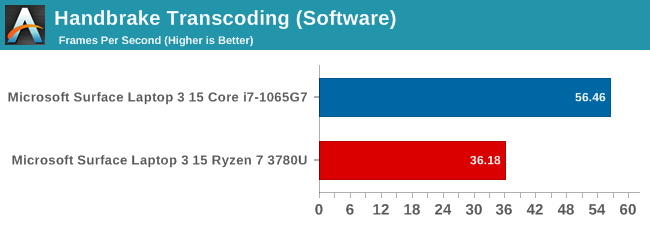
Transcoding is a popular task, and Handbrake is one of the most popular tools. For this test, a 1080p movie is converted to 720p using the x264 encoder. Once again, Ice Lake offers significantly more performance when transcoding in software.

Handbrake also supports various hardware encoders, such as Intel’s QuickSync, which provides significantly quicker transcodes at the same settings – albeit at larger file sizes and slightly lower quality compared to the software transcode, according to the Handbrake documentation. QuickSync has been very popular, and has been around quite a while. AMD also offers hardware encoding and decoding with their Video Core Next platform. Handbrake does support AMD’s Video Coding Engine (VCE) but the Surface Laptop 3 does not offer this as an option in Handbrake, so it was not able to be tested. As this is the only current Ryzen mobile APU we’ve tested, it may be a driver issue specific to the Surface branded processor.
x264
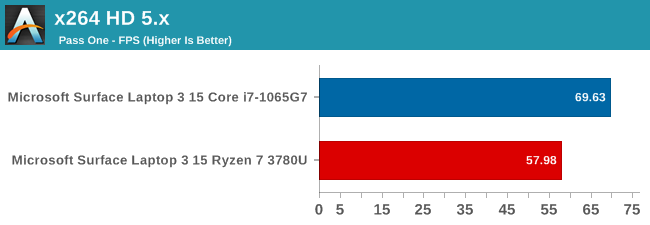
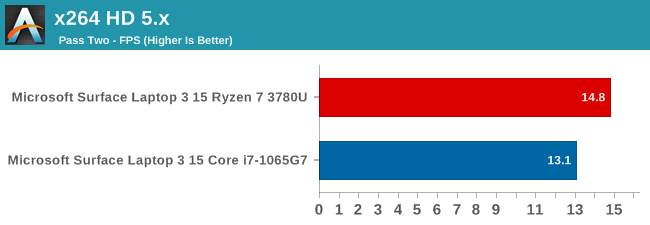
Our previous transcoding test, x264, was also run. Here we see that once again Ice Lake has a significant performance advantage, as it did with Handbrake software encoding.
Web Tests
All of our web tests were run with the current version of Microsoft Edge in Windows 10 1909. Web results are highly impacted by the underlying scripting engine, and Microsoft is going to be moving Edge from the EdgeHTML rendering engine to the Chromium open-source project that powers Google Chrome. When they make this change, expected early in 2020, we’ll revamp our suite with new tests.
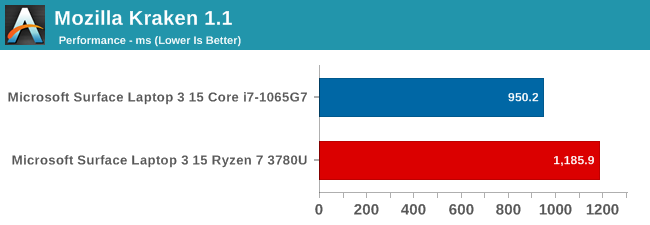

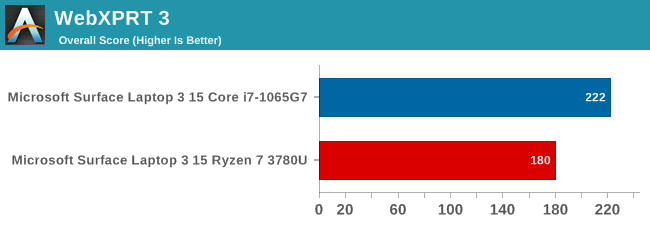
Intel has aggressively pushed their frequency ramping with Speed Shift, and one of the biggest beneficiaries of Speed Shift is web scripting, since the tasks tend to be very short. AMD is addressing this in Zen 2 with Collaborative Power Performance Control 2, or CPPC2, which is not as elegant of a name as Speed Shift, but promises to drop Zen’s frequency ramping from ~30 ms to ~1 to 2 ms, and will be a welcome addition on our web tests.










174 Comments
View All Comments
lmcd - Friday, December 13, 2019 - link
There was a window where Intel was still mostly shipping dual-core i5s while AMD shipped the 2500U and 2700U for around the same price. Made for an interesting situation where the AMD units were effectively light-weight desktop replacements, while the Intel units served as ultralights, all while theoretically serving the same market.Point being, there already was a moment where AMD laptop recommendations have made sense.
Also worth noting that Intel's H-series laptops would be a great place for AMD to compete. I'm still unconvinced AMD's core design scales down that well, and afaik Ryzen Mobile still uses the desktop process nodes? So this might be an area where Intel still has a manufacturing advantage -- midrange power consumption.
Teckk - Friday, December 13, 2019 - link
Yes. Need more wins with HP and Dell, something like XPS. Not happening till mobile Zen2 at the very least.nathanddrews - Friday, December 13, 2019 - link
Ice Lake + G7 is giving me flashbacks to the Pentium M/Yonah era buzz.strahinja78 - Friday, December 13, 2019 - link
yeah,...and that wouldn't be good for AMDGreenReaper - Friday, December 13, 2019 - link
They need Zen 2 out on mobile. It'd sort at least half of the performance issues. Better memory would help there, on power, and with graphics as well.MBarton - Monday, December 30, 2019 - link
Zen 2 mobile is a low priority when server and HPDT have much higher margins. AMD needs to offer something competitive when they can afford to, but their margins is key to their financial recovery. Semi-custom CPU's for consoles are low margin, but at least in that case the volumes are so high and they're gaining a potential advantage in gaming by pushing game developers to optimize for RDNA.nathanddrews - Friday, December 13, 2019 - link
But it would be good for the consumer to get some serious computing power with energy efficiency in the mobile space that has otherwise been stagnant for a while.HStewart - Saturday, December 14, 2019 - link
The current Lice likes are consider lower watt models and replacements for higher end IceLake are probably in early 2020 - likely 6 and 8 core models and higher end GPU's.Not intended as gaming CPU's
Korguz - Sunday, December 15, 2019 - link
" higher end IceLake are probably in early 2020 - likely 6 and 8 core models and higher end GPU's. " um yea ok Hstewart, and you have proof of this how ?? my guess. you dont and this is just more of your pro intel opinions.HStewart - Friday, December 20, 2019 - link
Well it just base on Intel road maps with 10nm - it might not be Ice Lake and could be next version. There is no difference in this than people saying wait for Zen 3. So do you expect that Intel will be always on 14nm and current processor will only be on 10nm. Intel has expected roadmaps on 7nm and even far less, I believe and it just a feeling that this battle with chip size will be over next year. Just remember what Intel did during the Pentum 4 days with Frequency wars especial with Intel came out with I series. Until the Zen came out Intel was really look like a monopoly but in reality it is not just AMD was doing so poorly But AMD did Intel a blessing, competition helps company from being lazy and ineffectiveBut I just and older profession who send technology from the early days including original IBM PC with Intel 8088 cpu.